Mars Opposition 2022
A blog of all posts for the 2022 Opposition
Mars Opposition Blog 27 March 2023
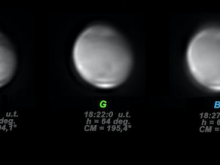
Observations are continuing, although the disk diameter is now only some 6 arcseconds. It is a challenging planet visually, requiring high powers and good seeing. I am hoping that as many as possible will continue, but I am going to make this blog post my last one of the apparition. Later, I will do a write-up for the Journal.
An amended list of observers has been posted on the front page.
The NPC has considerably decreased in size, but it is not yet especially well presented. The clouds over the S. pole are still impressive.
White cloud activity in general has continued, with a very bright bluish-white cloud persisting over Argyre in recent weeks. M.Lonsdale’s images of Feb 19-20 indicate a weak brightening at Edom in the afternoon. This was found after further investigation to be due merely to diurnal cloud, and is unrelated to the predicted ‘flashes’ mentioned in an earlier posting. I made a careful search of all data for the period Jan-Feb preceding this date but without any other positive result.
P.G.Abel has compiled an apparition map from his own drawings and I am posting it here. On his BAA member page there is a second version with names added. Makoto Adachi likewise has made a map from the images submitted to ALPO Japan, and will be publishing it on that website.
Ls has recently passed the 40 degree mark and now is the moment when good blue-violet images are showing the complete Equatorial Cloud Band (ECB), as we would predict. Here is an image by R.Sedrani for March 22, where the band stretches from Elysium, which is approaching the CM, towards Isidis Regio/Libya on the morning terminator. (Note also the evening orographic clouds upon this image.) The ECB scatters blue light, and it can cause the Syrtis Major to appear slightly bluish at the edge of the disk where the effect is enhanced. See the image by G.Walker. (See also the broad, warm-toned E-W dark belt upon this image, located just north of the S. polar cloud: this seems to be one of the features we called ‘violet holes’ in past reports where the atmospheric concentration of water ice is locally greatly reduced.) But even near the CM the ECB effect can be detectable. I noticed it upon an image by J.Willinghan taken on March 21.
The Director will be speaking at the Mercury & Venus Section meeting on the Saturday of the forthcoming Winchester weekend. I will also bring an historical exhibition. If you are going to be there please come and say hello, and do send me an email in advance to say that you are attending, so we can look out for one another.
Thanks again for all your efforts this apparition.

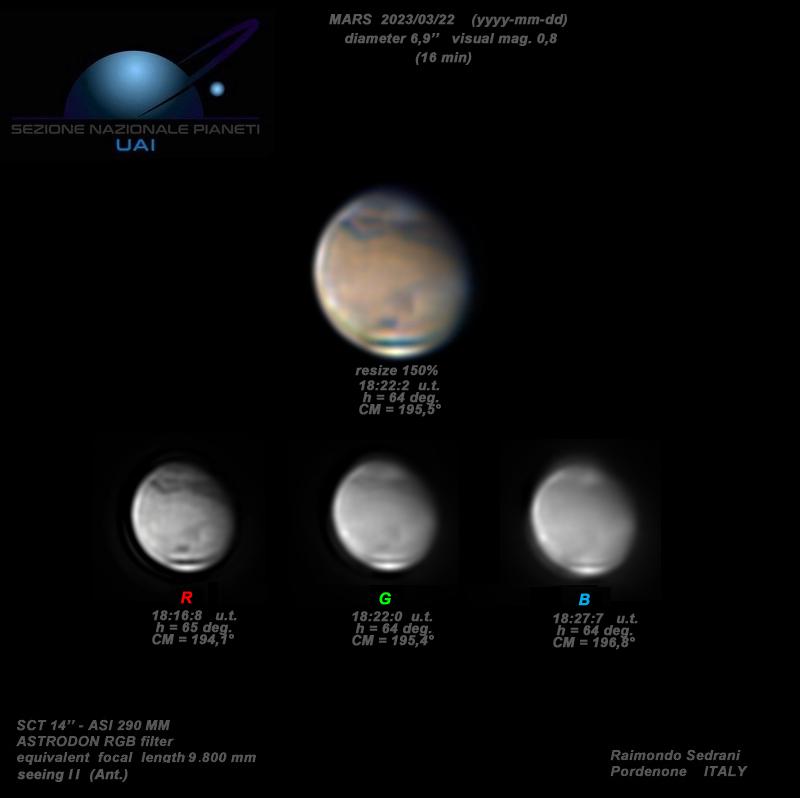
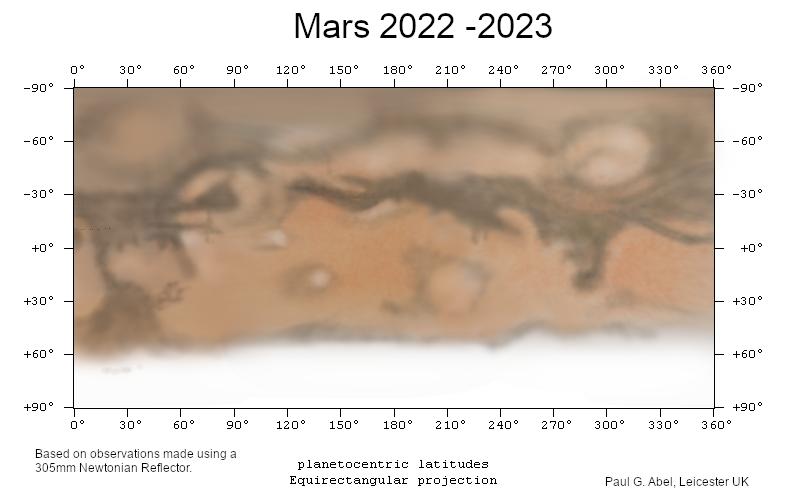
Previous Post: 19 February 2023
Entire Mars Opposition 2022 blog
Mars Opposition Blog 19 February 2023

With the arrival of batches of drawings from M.Green, A.W.Heath and P.Lyon the total number of observers has risen to 107. I have counted up all the images and drawings submitted and the total is just over 8,000, a very good result indeed for an opposition like the current one.
The southern white cloud areas (of which those over Ausonia, Hellas, Noachis and Argyre have been especially noticeable) have lately joined together to form a more or less continuous hood over the S. polar region.
Orographic clouds continue to be prominent, though we can now no longer watch the sunset terminator where they would be shown to the best advantage. For example see the nice image of Elysium Mons by P.Tickner on Feb 6. Morning clouds have been well placed for observation, and one has been dimming the Syrtis Major as it rises. The blue-violet images are characteristic for the beginning of the period when the Equatorial Cloud Band becomes more prominent across the disk.
As Utopia-Casius is coming back into view with the fall in the southward value of De, its southern tip appears quite flattened. See the image of E.Morales for Feb 12 (and Tickner’s of Feb 6). It will be remembered that some dust activity around Nodus Alcyonius was reported in a recent blog post.
We followed another small dust event at the S. edge of the NPC, east of Propontis. Attention was drawn to it on Feb 13 by C.Foster, whose images I have uploaded here in the collage covering Feb13-14-15. (As ever the dust is brightest in red, bright in green and inconspicuous in blue, and a yellow tint is visible in the colour image.) Several observers quickly responded to the call I sent out for additional observations. P.Tickner (UK) was able to take a useful image, while A.Snook (UK) and J.Warell (Sweden) just captured it at the evening limb.
Next day (Feb 14) Foster recorded only a small curved arc of bright yellowish dust in the original longitude; his RGB image – together with a higher resolution one obtained by N.Haigh from the UK – is posted here. A good image was secured by Tickner. K.Howlett (UK) was able to image it successfully too, and C.E.Pellier kindly sent me an image set by C.Viladrich (France), where it was visible near the evening limb. The dust cloud had clearly moved southwards in 24 hours. This movement and dispersal is shown more strikingly in the animation by N.Haigh posted here, with both images having been derotated to the same CM longitude (159.4 degrees).
On Feb 15 there were several observations made, including an image set by V.della Vecchia (Italy), whose work is posted here. Useful images were also taken by R.Sedrani (Italy).
On Feb 16 della Vecchia and others obtained images showing the dust was static and fading, which P.G.Abel could just confirm visually using a high magnification. For reasons of longitude, observers in Japan and the USA could not watch the event.
By the end of this month the sign of the sub-Earth latitude, De, will favour observation of the N. hemisphere. The shrinkage of the N. polar cap will be worth watching for those still able to observe. Visual observers ought to be able to do something useful with the disk diameter above 6 arcseconds until late April, and hopefully some imagers will go on for longer. The declination of the planet still favours N. hemisphere observers.
Observation is now becoming more challenging. Every result will be appreciated, and the recent dust event shows that Mars can give us some surprises even in northern spring!
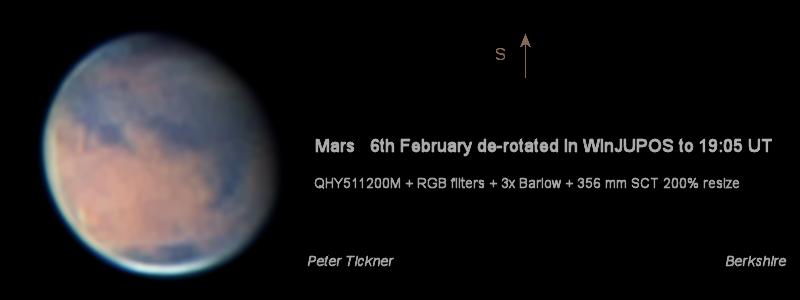
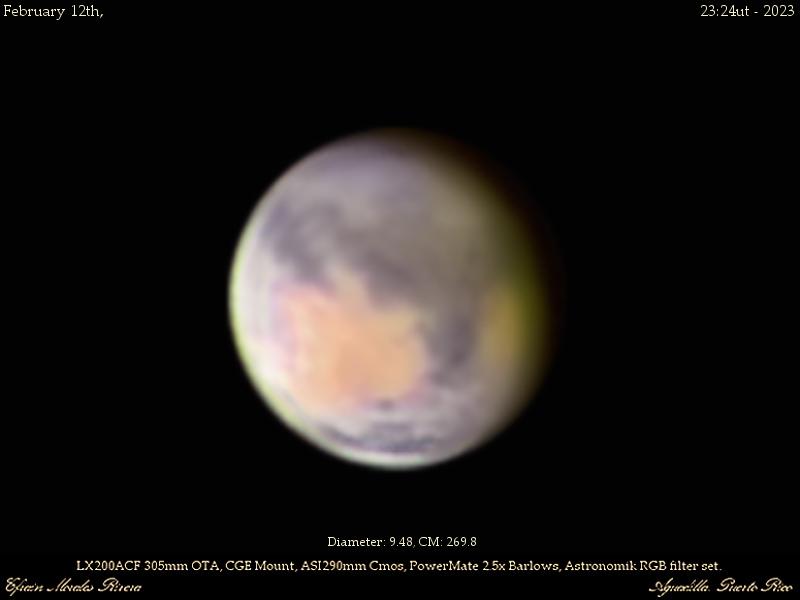
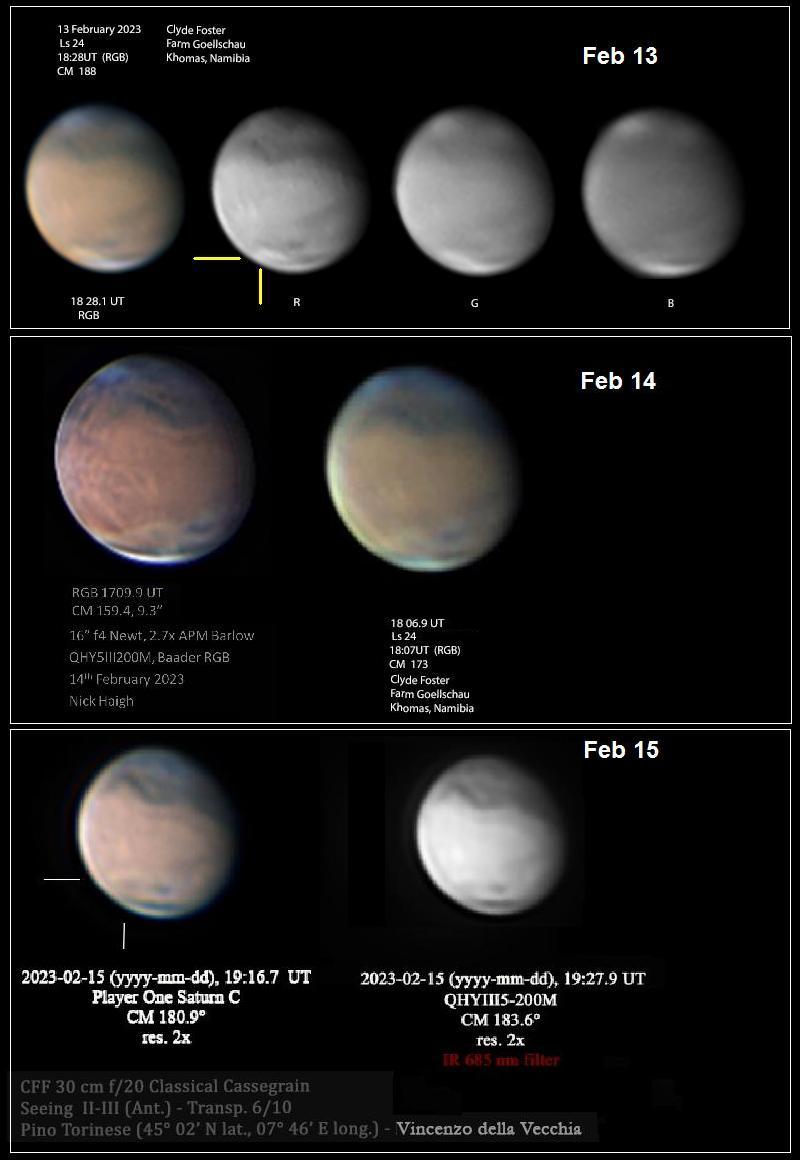
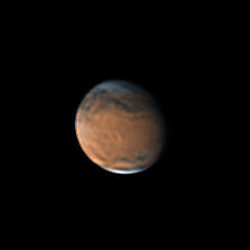
Mars Opposition Blog 6 February 2023
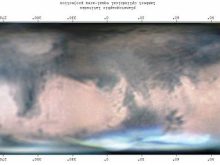
Today we are summarising the January observations. The disk now shows a notable phase, and is shrinking fast. Nonetheless I personally have continued to enjoy some fine visual views, especially in twilight, and have been able to make over 90 drawings so far this apparition. And we have now received data from 101 contributors, which is very satisfactory for a December opposition such as the present one. It is pity, though, to witness the slow decline in the number of visual observers.
I have received a global map made by Geof Lewis (Norfolk). It is a very nice piece of work, and the first 2022 opposition map I have seen. At his BAA member page Geof has produced another copy with names. The N. polar clouds shown on the map were imaged only upon specific dates, but their inclusion gives a graphic reminder of the sort of features that could often be observed in the north in 2022. I am posting a south up version here.
The greatly foreshortened north polar cap is still not completely free from hood, but it shows a dark border. There have been some patches of hood around the morning terminator, particularly in the longitudes around and immediately following Mare Acidalium, where a strip of white cloud – parallel to the cap – often extended from the noon or afternoon Acidalium to the terminator. The latter is shown very well upon the map.
In the south, there have been various isolated thin clouds, and a specific and very bright cloud has recently collected in the Argyre basin, persisting throughout the martian day. There have been a number of other discrete bright morning clouds at the same latitude, in Hellas and Noachis. Hellas is again very bright in the early afternoon. On Jan 29 I observed over several hours to watch bright white clouds rotate with the basin until it reached the evening limb. But a continuous south polar hood has not been seen.
An increase in equatorial cloud has been noticeable. We have a persistent bright area on the evening side, which must be part of the seasonal Equatorial Cloud Band (ECB) enhanced by the greater optical depth at the limb. Later this will thicken and extend across the disk when seen in blue light. Historical data show that it begins around Ls 0 degrees, but is rarely continuous before around Ls 45 degrees. (On Feb 10, Ls reaches 22 degrees.) At the same time, we are seeing morning terminator clouds to much better effect. Of these, the aforementioned cloud following Mare Acidalium has been prominent. We have seen evening orographic clouds over some volcanoes.
In the absence of specific dust events, the albedo features do not show much intrinsic change. However, I have noticed that the dark area on the north following side of the Syrtis Major, which developed greatly at the time of the 2018 global dust storm, and which was less prominent during 2020, has been further fading, thereby narrowing the N. part of this feature. From being blunt-ended, it is now more tapering. See the Jan 8 image by Gary Walker.
I am posting a number of current images, along with some earlier ones from 2022 Oct-Dec for comparison. Thus Paul Maxson’s image of Oct 30 shows Hellas filled with yellow dust fallout. A month later Damian Peach’s high resolution image shows how faint the surroundings of Elysium have become, and also an opposition brightening of Elysium Mons and Hecates Tholus. Ella Bryant’s image of Nov 19 reminds us of the persistent partial transparency of the north polar hood in the N. of Mare Acidalium. It is very instructive to make monthly comparisons at the same (or nearly the same) CM longitude.
It is important to keep observing, to continue to record the seasonal changes in the white cloud activity, in particular. We normally follow the planet up to a few weeks before solar conjunction…… which will not be due until November 18!
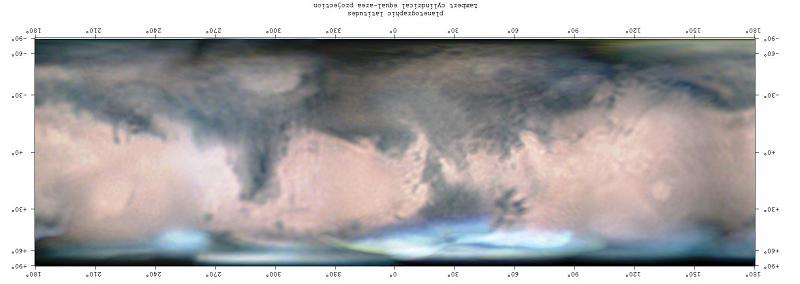

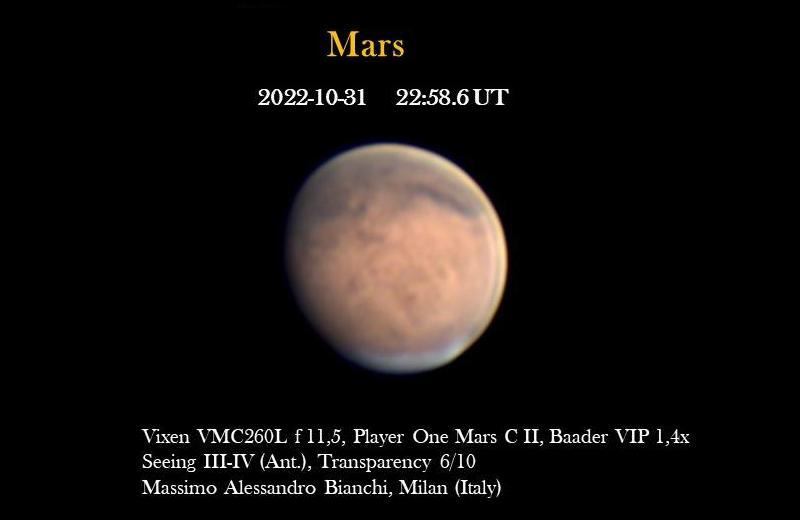
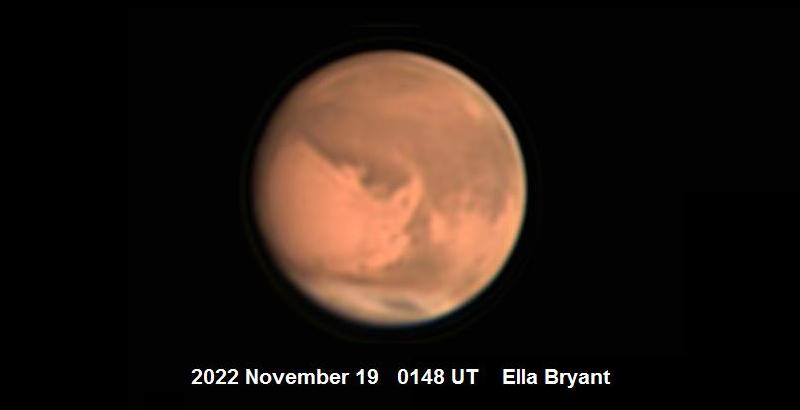

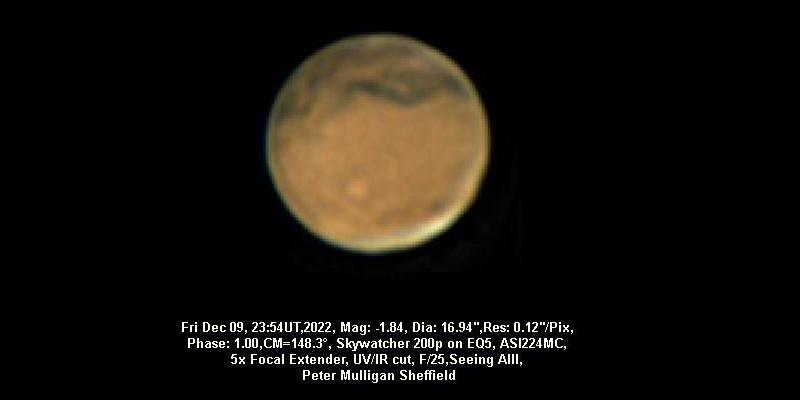
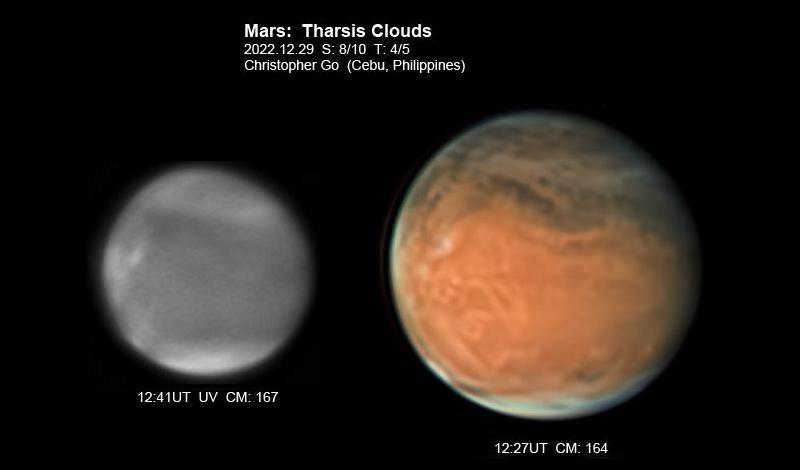
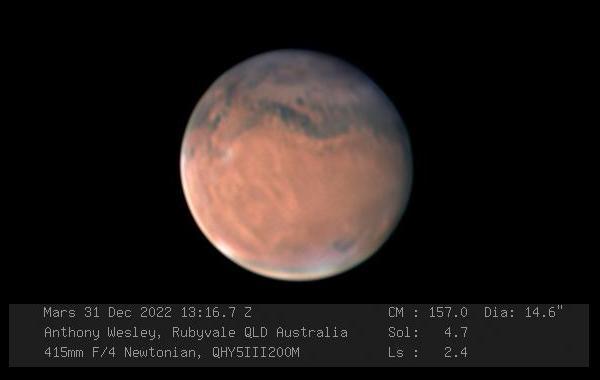
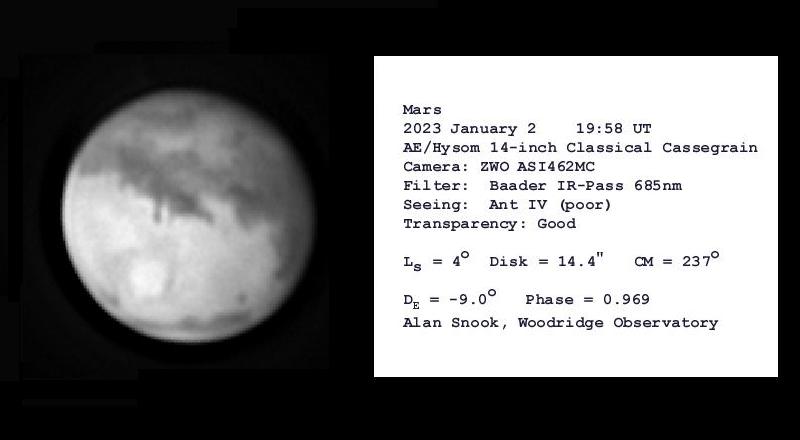
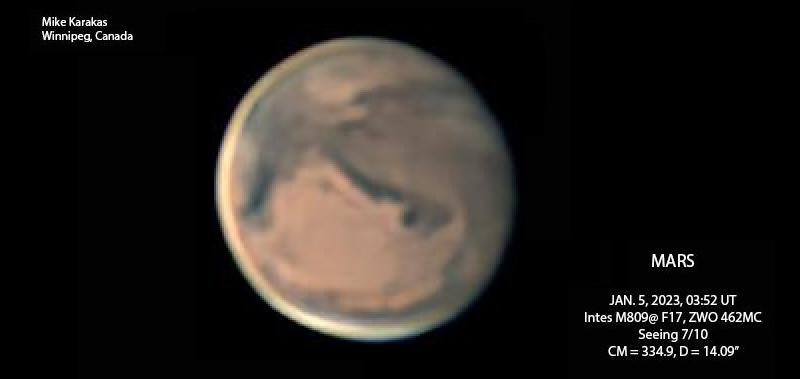

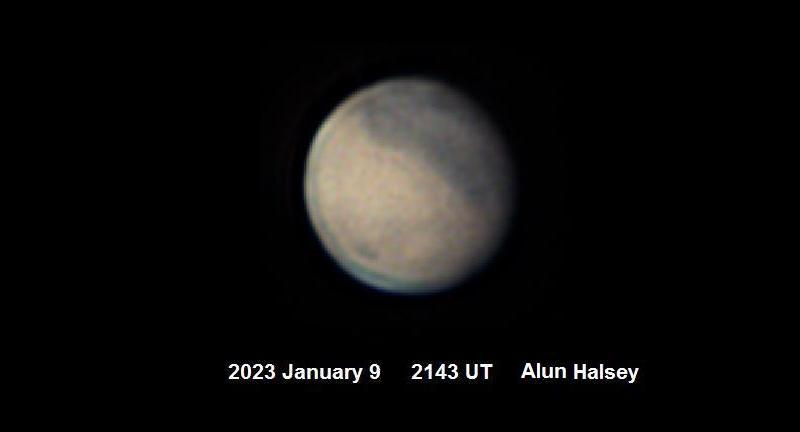
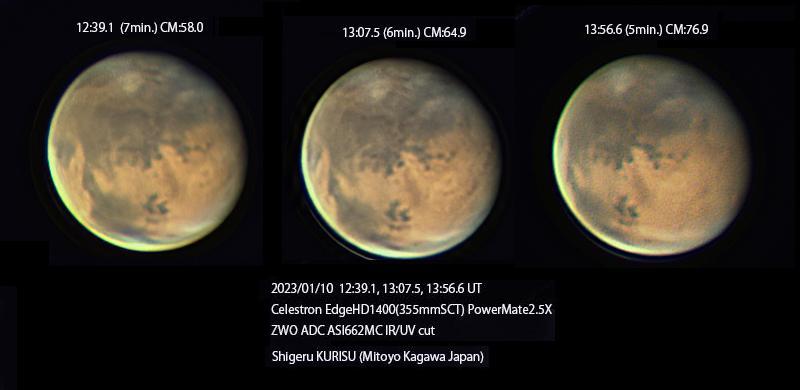
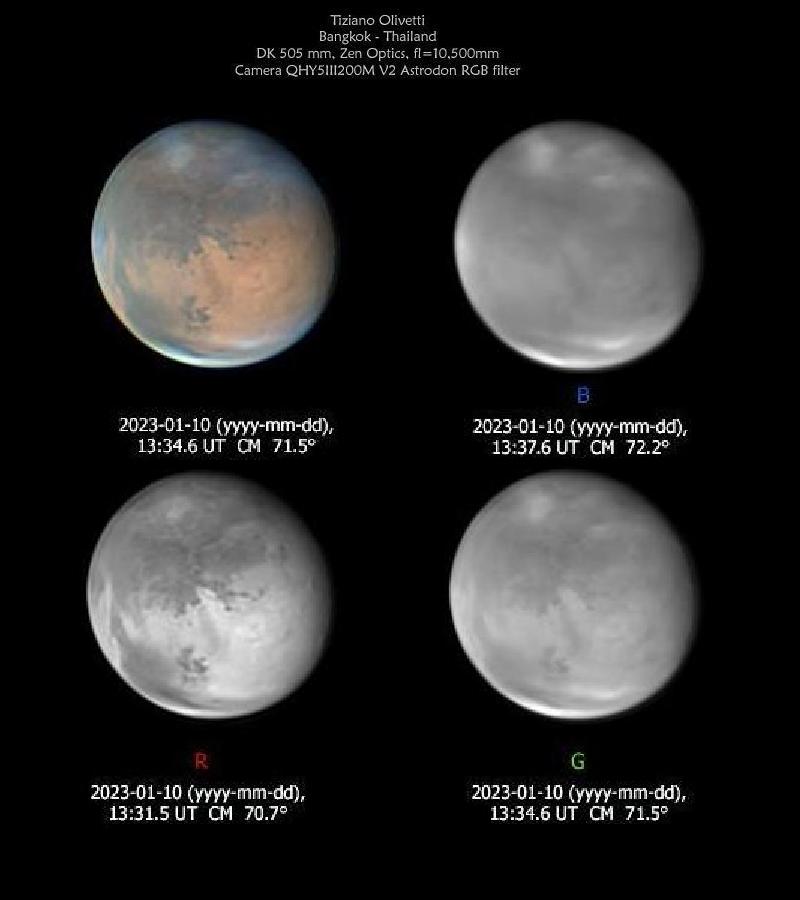
Teaser image: Mars Map 2022 by G D Lewis
Mars Opposition Blog 11 January 2023

With this first post for 2023 I wish you all a Happy New Year. Let us hope that globally it will be a much better one than was 2022. We have now received data from 98 individuals. The list of observers on the front page has been updated. This summary continues the record up to 2022 Dec 31. You might be interested to know that we observed on 328 out of 365 days in 2022.
The UK weather immediately following opposition did not produce too many clear nights. The Director was abroad for nine days over Christmas in the Czech Republic from where he made a few drawings with a humble 70 mm refractor. Severe weather at this time was reported in parts of the USA, and much cloud or bad seeing seems to have dogged many observers in other countries. But at least a few clear nights in the UK yielded good seeing, and observers have taken every opportunity to acquire more data. David Arditti, BAA President, was able to record considerable detail in the Tharsis region on December 10, in his image posted here. The images by Chris Dole (Dec 14) and John Saxton (Dec 16) clearly show that the large aspect of the Solis Lacus, with the N-S canal-like streak of Phasis following, persists.
The NPC is to be seen as a thin bright strip along the N. limb, but the hood persists in some longitudes on the morning side, and it is still rather more apparent around the longitudes of Utopia and Mare Acidalium: witness the image of Martin Lewis for Dec 20, and another by Michael Buechner (Germany) taken on Dec 25. (As of now, early 2023 January, the hood has declined considerably.) We have had an increase in diurnal cloud activity, and the orographic clouds over the Tharsis Montes have been recorded in several images. See the ones for Dec 27 by O.Inoue (Japan) for instance. And there has been a persistent morning cloud around the latitude of Hellas.
A very small and very bright cloud at the S. edge of the N. polar hood appears on the images by W.D.Flanagan for Dec 18 posted here. Others also recorded it.
As cloudy activity at the N. pole declined, there has been more seasonal cloudiness around the S. pole.
There has been a little dust activity too. On Dec 19 T.Olivetti (Thailand) recorded a bright strip of yellowish dust detached from the polar region, lying to the west of Casius-Utopia. Next day this dusty area seemed to form the more yellowish p. end of a strip of hood. By Dec 22 the dusty area seemed to have travelled further east, while on Dec 23 it was succeeded by a much longer E-W orientated strip of dust which veiled Nodus Alcyonius. (Incidentally this feature has been much smaller of late, and the teardrop shape it exhibited a decade ago is gone.) I have made a collage of these images, enhanced the contrast of the Dec 23 image (which in contrast to the others was secured in poor seeing), and arrowed the position of the dust areas on Dec 19 and 23. These images also show persistent morning cloud at the latitude of Hellas, and I add a further image by R.Sedrani (Italy) for Dec 25 that shows the same effect at a different longitude.
I have suspected other small-scale dust activity within or at the edge of the polar hood at other times.
Finally I want to ask observers to obtain as many blue and violet images as possible, as they make it easier to record the seasonal equatorial cloud belt and other delicate white cloud phenomena. Very good examples of what is required can be found in the set of images by Christophe Pellier (France) from Dec 10 or by Vincenzo della Vecchia (Italy) from Dec 12.

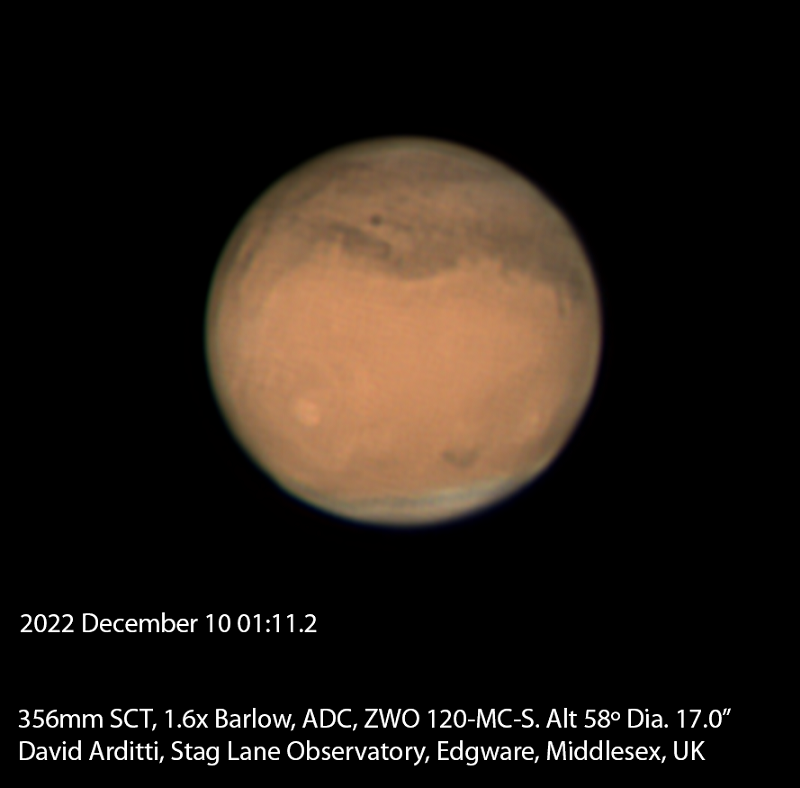
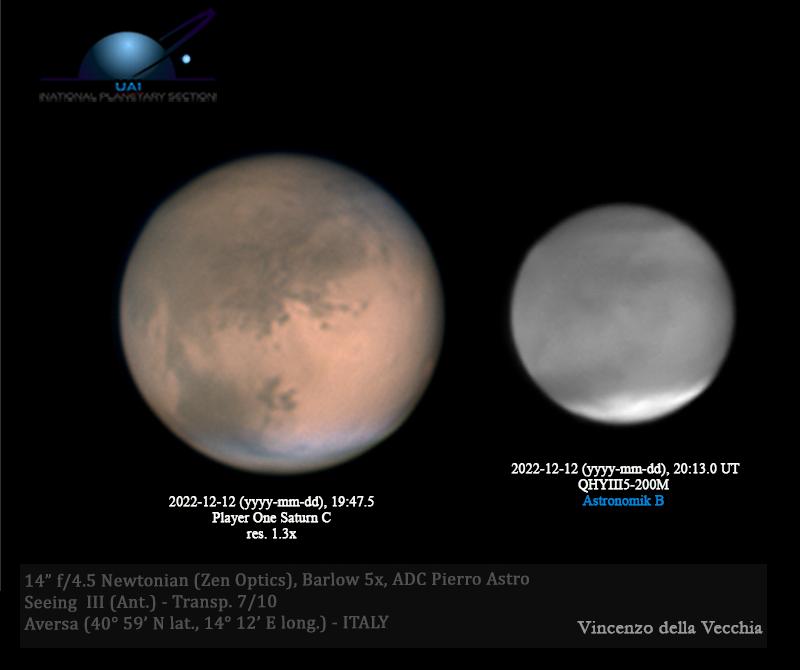
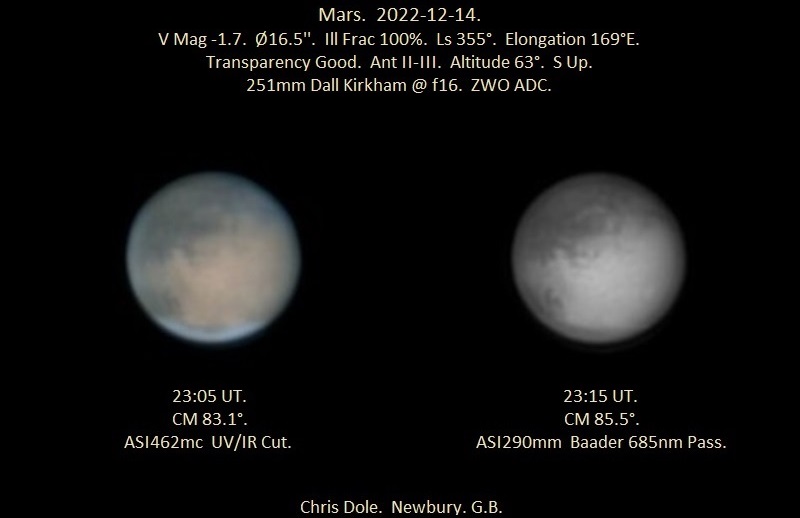


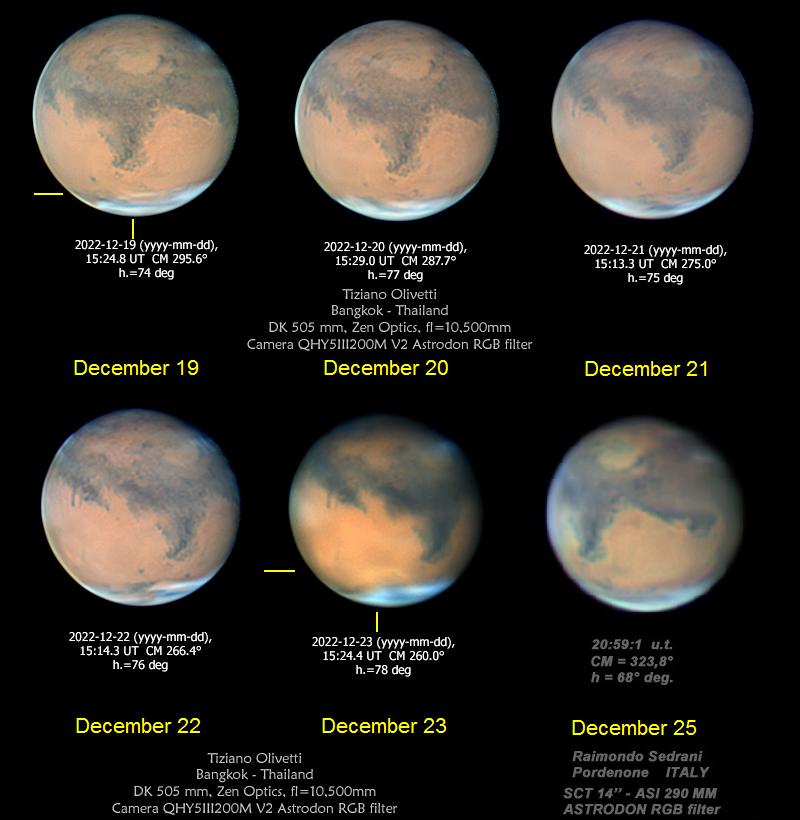
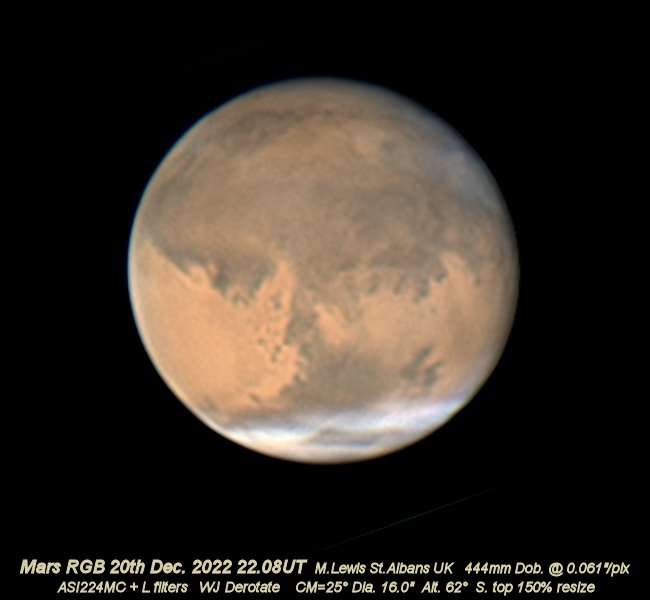


Mars Opposition Blog 14 December 2022
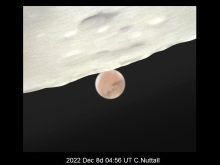
A week after opposition, and the final blog post for the calendar year, as observations have been continued by over 90 individuals, and examples of the work of 43 of them have so far featured on this blog.
After mid-November the UK weather became exceptionally cloudy and wet but shortly before opposition it improved. The writer had clear skies on the five consecutive nights from December 6-10 for example, and many UK observers – the writer included – watched the spectacular occultation of Mars by the Full Moon in the early hours of December 8. Here I have space only for a drawing by C.Nuttall (York) and an image by Sean Walker (New Hampshire, USA).
Attention has focused upon watching the ever-changing configurations around the N. pole. The ground cap has definitely been visible at times, but there have remained variable amounts of polar hood. Examples of images and drawings are given here by P.G.Abel (Leicester), W.J.Leatherbarrow (Sheffield), T.Olivetti (Bangkok, Thailand) and M.Piccoli (Udine, Italy) to show the variability of the area in recent weeks.
Several features such as Olympus Mons, Hecates Tholus and Elysium Mons have shown an opposition brightening for a week either side of opposition, although they were all cloud-free at the time. At the same time there have been increasing amounts of equatorial cloud visible, for example at Chryse-Xanthe, Eden, etc. Tempe, adjacent to the polar hood/cap has shown a marked diurnal brightening, and Alba has been light, next to the edge of the polar hood.
Several observers in the USA and Australia made systematic patrols to see if there would be any specular reflection or ‘flash’ from Edom (Schiaparelli) according to the predictions published in Sky & Telescope. Anthony Wesley and Phil Miles made video sequences over the predicted time ranges, starting earlier and finishing later. Their results were negative, as were those of other observers such as M.Caruso, F.J.Melillo and N.MacNeill. It seems to me that the equivalence in De and Ds occurred at a latitude slightly too far north to coincide with the near-horizontal areas of reflective minerals in this crater.
Remember, images have to be formally submitted to be considered a contribution to the Section’s work. There are quite a number of members posting images at the BAA website who never send them to the Section: a pity.
Part 2 of the final 2018 opposition report has now appeared in the December Journal. (Preview link; full PDF is for BAA members only.) The Mars opposition blog will continue in the New Year. Good observing!
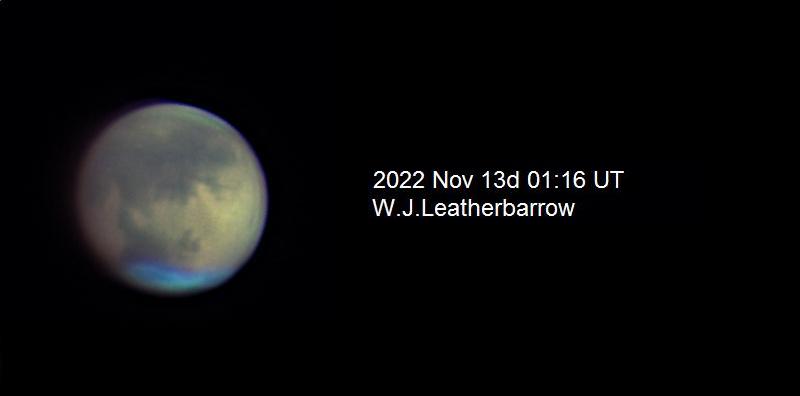
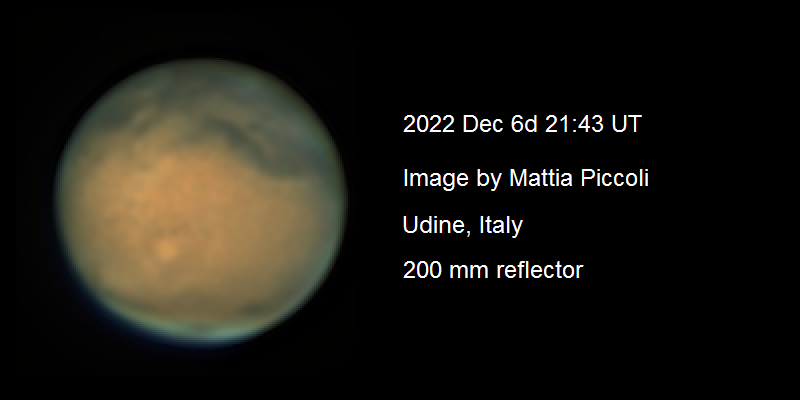

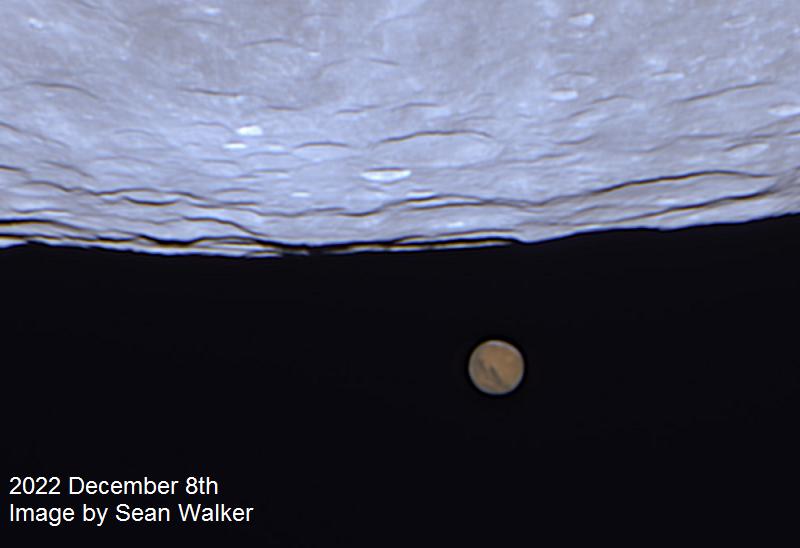
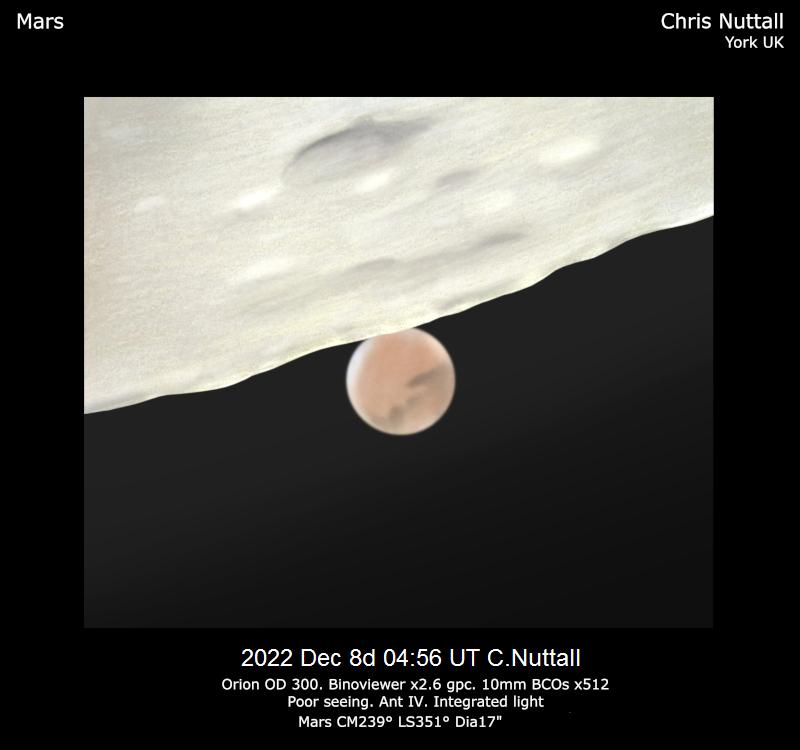

| The British Astronomical Association supports amateur astronomers around the UK and the rest of the world. Find out more about the BAA or join us. |
